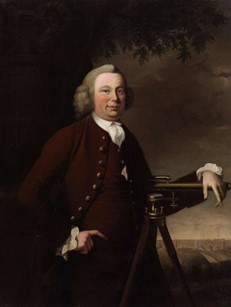
James Brindley, who devised the Oxford Canal as part of a scheme linking the Severn, Thames, Trent and Mersey
In 1774 the building of the Oxford Canal reached Napton. The canal was routed around three sides of Napton Hill to save building numerous locks across the village. However, the climb from the wharf at Napton to the summit at Marston Doles still required the construction of nine locks. The work was finally completed in 1790, but not before contributing a violent incident to the history of Southam.
It was reported at the time that ‘navvies’ or navigators, usually single men living in shanty towns of simple wooden sheds, were living in the Napton Fields area. These men often came into Southam to frequent the many public houses and ale houses, including the Bowling Green in Coventry Street and the King’s Head, then situated on Market Hill.
The navvies were employed to dig out the canals (cuts), hard manual labour attracting strong, hard-working and ‘hard drinking’ men who often enjoyed brawling. Although many were of Irish descent, others came from agricultural areas such as Lincolnshire and towns in the north, where work was often seasonal. They travelled around the country in gangs looking for the best wages. Their insanitary living conditions propagated such diseases as cholera. It was perhaps inevitable that their reported excessive drinking often led to trouble.
One incident is set out in the town’s churchwardens’ notices for January 2, 1775, when a workman named Giles, who was drinking at the King’s Head in the Marketplace, abused and struck the landlady, Mrs Dorothy Ward. Peter Raven, the elected senior constable, was called, supported by his three thirdboroughs (constables) Thomas Billingham, a whitesmith (a metal worker employed in finishing products in lead, pewter and silver), Thomas Archer, a butcher, and Michael Knight, a cooper. They held the assailant and locked him in Raven’s house for the night with four guards.
Brought before the petty sessions, he was found guilty by the magistrate, the Reverend Joseph Davie, of violent affray and wounding, and committed to Warwick Assizes. At that time the parish was obliged to pay the costs of guarding the prisoner, which included meat from Thomas Archer, 5s 6d; ale at 6s 6d; two loaves of bread; ‘garden stuff’, 2s and lodging of four guards for the night and a day, 4s.
Constable Raven took up his story in writing:
‘…I had him to three public houses for the night and the rest of the day, and nobody would take him in for fear the Navigators should “…pull down our houses.” So I was forced to take him to my own house with four guardsmen. Some good men hearing the Navigators saying they would rescue him before morning, six men came to my assistance…in the night my house be set by seven men, twice, but they found the guard was strong so they did not meddle.’
The following day Giles was escorted to Warwick and there were no further reports of trouble.
In a way this anecdote illustrates how well the townspeople kept law and order before the creation of police forces. The parish constable, appointed unpaid for one year, was expected to maintain order, ensure apprentices behaved and look out for vagabonds. In addition, all local people were duty bound to help the constable, as indeed happened when, ‘…six men came to my assistance.’
Southam Heritage Collection is located in the atrium of Tithe Place opposite the Library entrance. We are open on Tuesday, Thursday, Friday and Saturday mornings from 10am to 12 noon. To find out more about Southam’s history, visit our website www.southamheritage.org telephone 01926 613503 or email southamheritage@hotmail.com You can also follow us on Facebook.

Leave A Comment